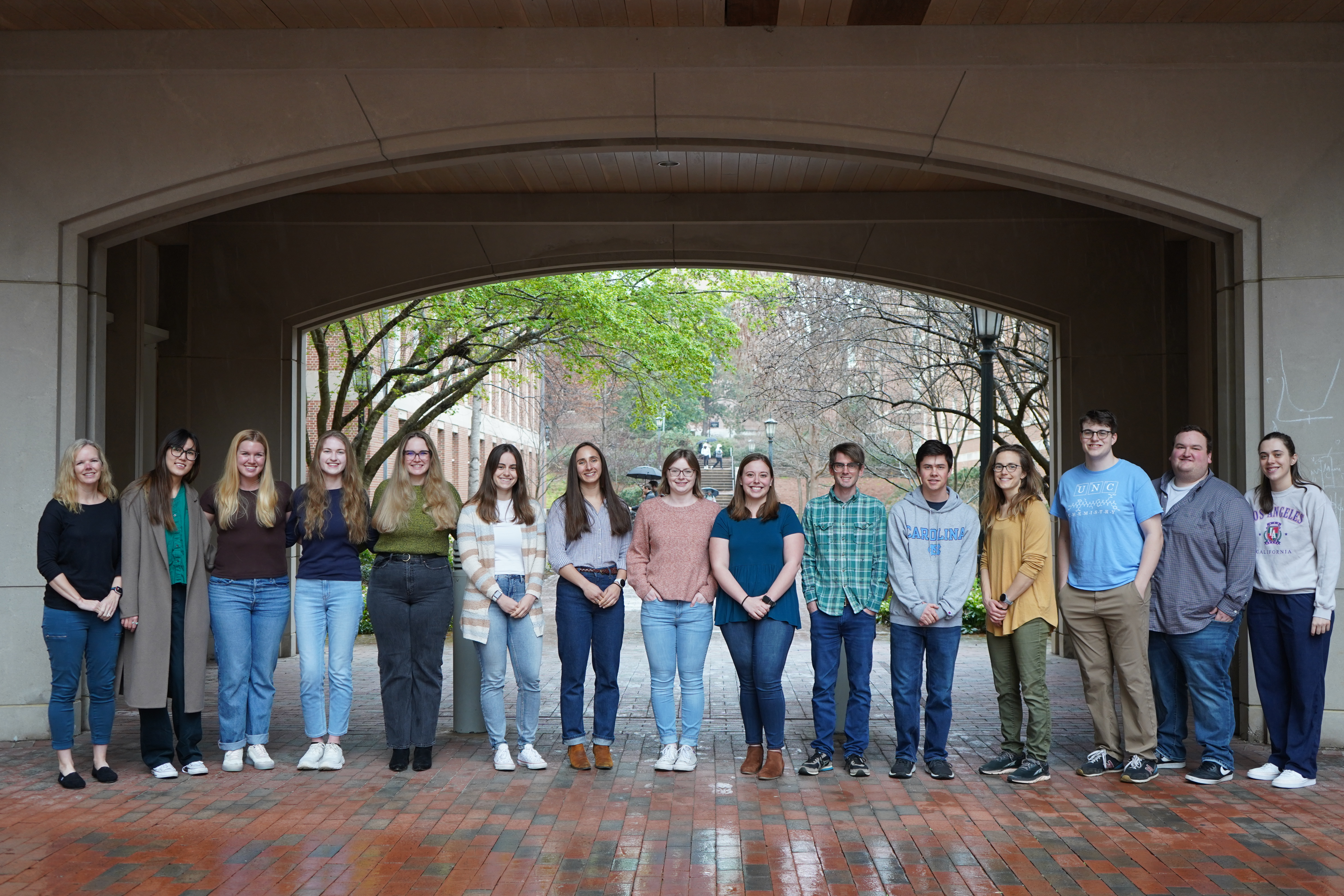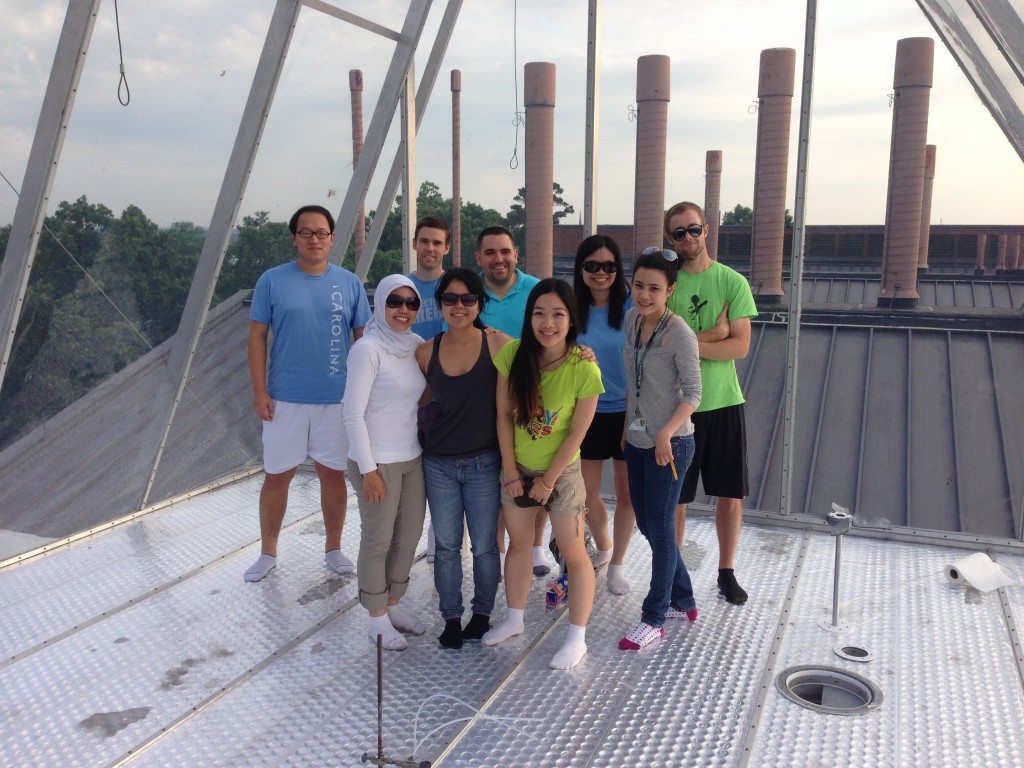Faculty Members

Erin Baker
Associate Professor
Caudill Laboratories 017919-445-1189
erinmsb@unc.edu
Group Website
Research Interests
How the Environment Affects Human Health, Molecular Biomarkers, Analytical Separations, High Throughput Screening, Mass Spectrometry, Ion Mobility Spectrometry
Research Synopsis
Measuring chemical exposure is extremely challenging due to the range and number of anthropogenic molecules encountered in our daily lives as well as their complex transformations throughout the body. To broadly characterize how chemical exposures influence human health, a combination of genomic, transcriptomic, proteomic, endogenous metabolomic, and xenobiotic measurements must be performed to understand the different molecular changes occurring. However, while genomic, transcriptomic, and proteomic analyses have rapidly progressed over the last two decades, neither xenobiotic nor endogenous metabolite small molecule measurements have advanced to as great of a degree, even though they are essential for the direct analysis of chemical exposure.
Therefore, the Baker Group is working to develop and optimize new analytical and computational approaches for these measurements. Specifically, they are using various combinations of separation methods including automated solid phase extractions, liquid chromatography, supercritical fluid chromatography, ion mobility spectrometry and mass spectrometry to enable the analysis of thousands of longitudinal samples over the lifetime of exposure.
These analyses allow the assessment of both xenobiotic and endogenous molecular changes to probe the perturbations occurring. Additionally, the Baker Group is creating computational software programs and approaches using R, Python, Java and machine learning for the evaluation and visualization of the molecules they have detected and samples they have analyzed. These new computational capabilities are enabling improved mining of the data and more associations to be formed in the populations studied.
Finally, the Baker Group is extremely passionate about promoting their research and STEM careers to the general public through community engagement and outreach. Thus, they present at various international and local conferences and are excited to get into K-12 schools once the pandemic has lessened.
Professional Background
Erin received her B.S. in chemistry and a minor in mathematics from Montana State University in Bozeman. At MSU, Erin performed undergraduate research in Eric Grimsrud’s lab using ion mobility spectrometry (IMS). She pursued IMS even further during her Ph.D. research in Michael Bowers’ Group at the University of California – Santa Barbara where she evaluated DNA duplexes and quadruplexes by coupling IMS with mass spectrometry (IMS-MS) measurements. Erin then traveled to Tricities, WA where she was a post-doctoral researcher and then a scientist in Richard Smith’s group at Pacific Northwest National Laboratory.
Research Group
The Baker research group utilizes multidimensional separation techniques such as solid phase extractions, liquid chromatography, ion mobility spectrometry, and mass spectrometry to evaluate molecules present and changing in biological and environmental systems. Research projects include the development of high-throughput analyses to study numerous samples in a short time period as well as informatics studies to evaluate and connect the complex multi-omic data with available phenotypic data.
News & Publications
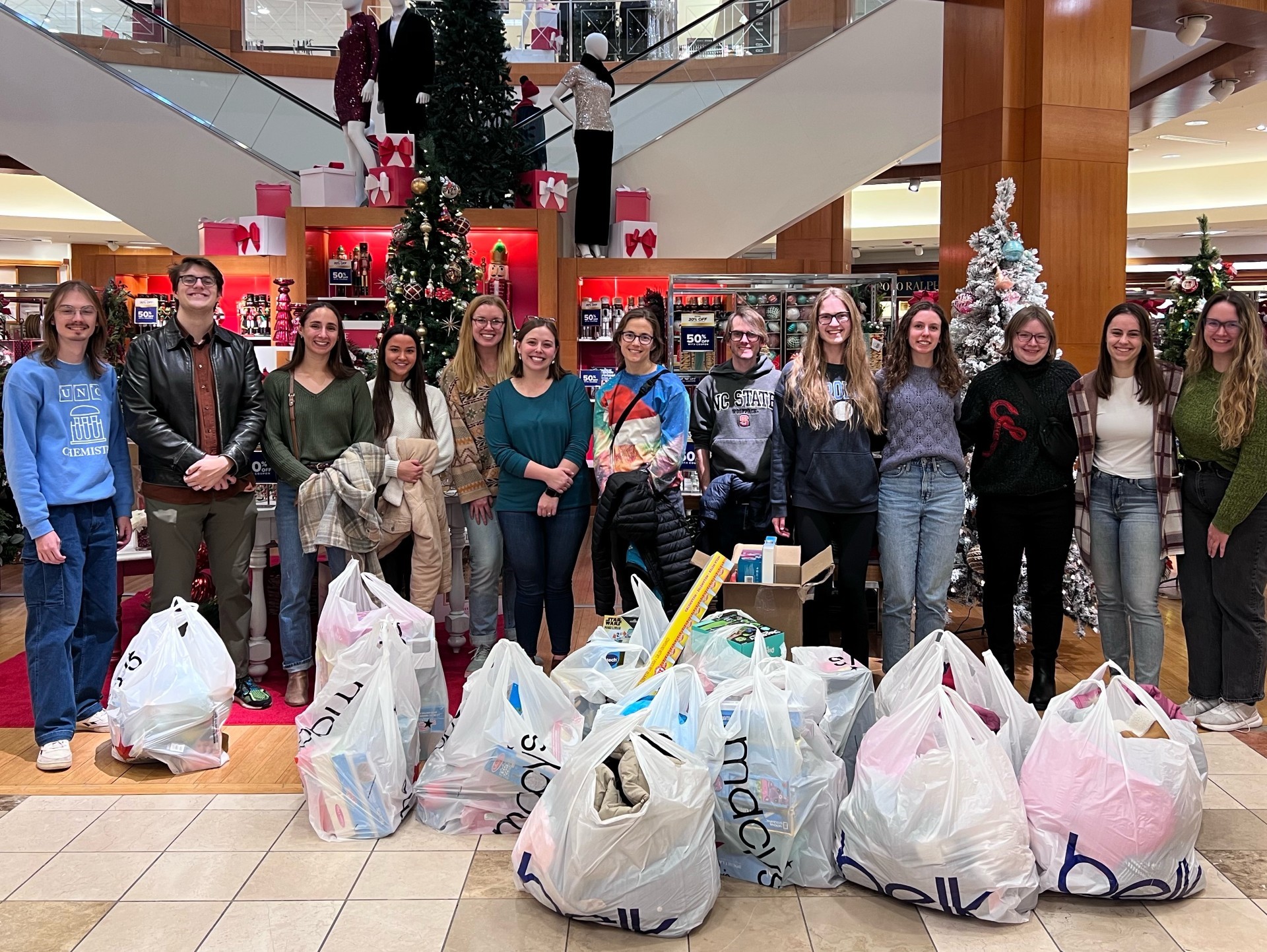
Each holiday season, UNC chemist Erin Baker and her lab trade data analysis for presents — rallying fellow Tar Heels to raise money for Toys for Tots and Coats for Kids.
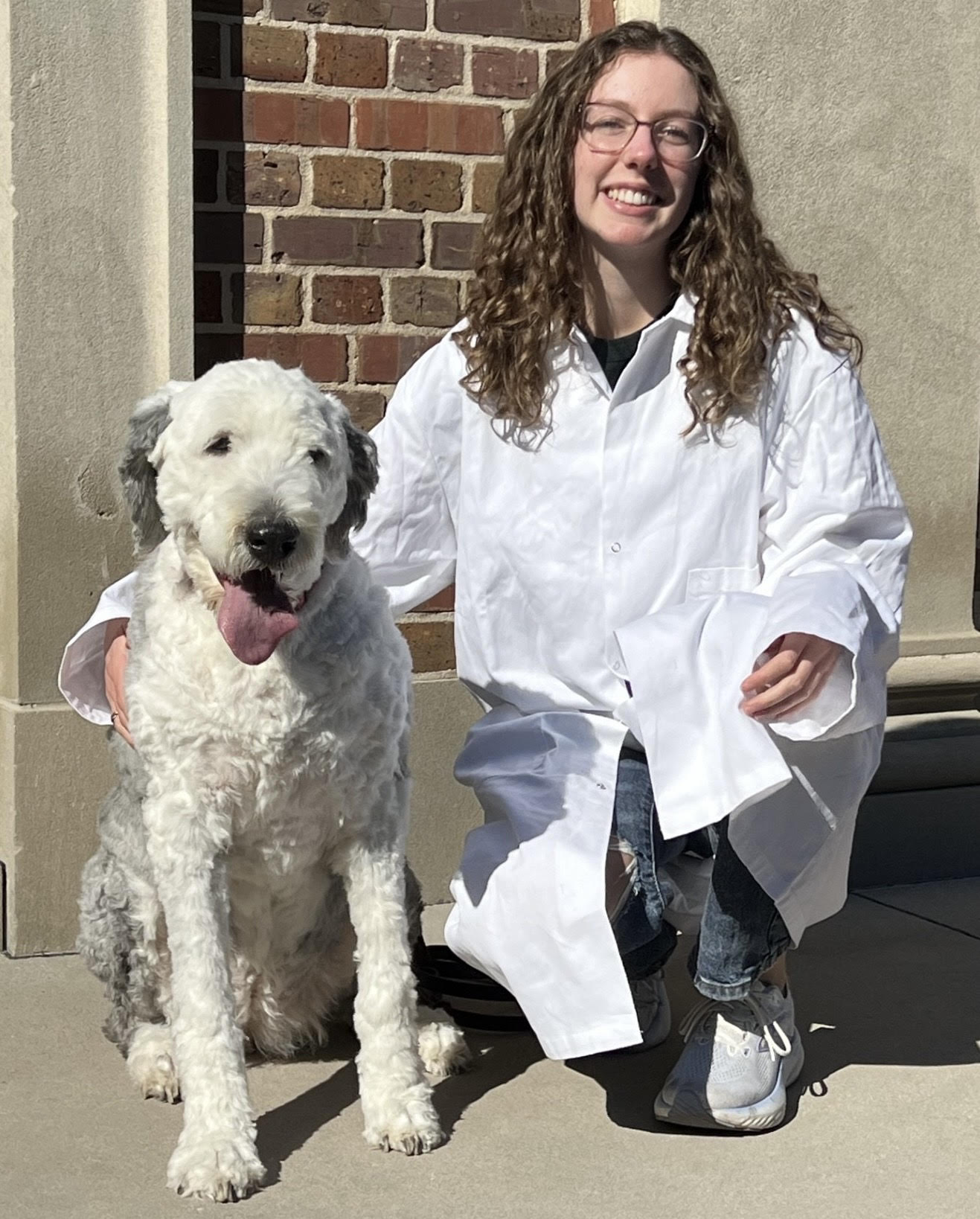
Sarah Rehm, a chemistry major, is studying how pollution from a group of toxic compounds known as PFAS, or forever chemicals, is affecting pets and wildlife..
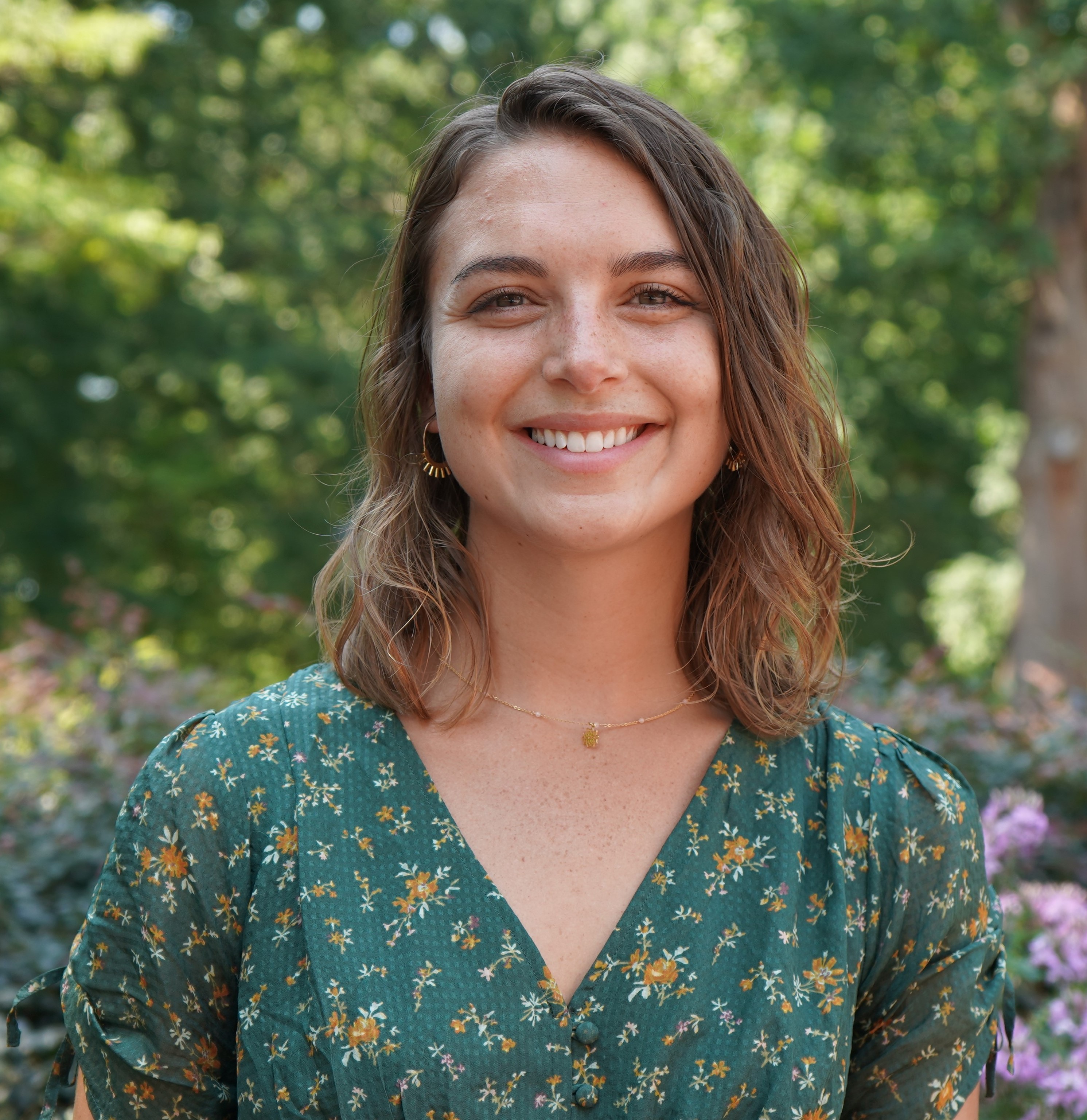
Jade Fostvedt
Teaching Assistant Professor
Kenan Labs C147B919-843-7100
jfost@unc.edu
Curriculum Vitae
Research Interests
Chemistry Education; Inorganic and Organometallic Chemistry
Research Synopsis
I am trained as a molecular inorganic chemist, specializing in the design of reactive organometallic complexes. To this end, I employed air-free synthetic techniques to isolate metal complexes and subsequently investigate their reactivity. My graduate research aimed to explore novel complexes containing early transition metal centers (namely Nb and Ta), with the goal of using these complexes to carry out difficult chemical transformations of abundant diatomic molecules, such as H2, N2, and CO. My research provided me with a fascinating molecular playground in which I could see the concepts I learned in the classroom come to life. In my current role as a teaching professor, I aim to help students develop their own passions through chemistry.
Chemistry has a reputation among students as being a particularly challenging subject to learn. However, a dedicated and innovative teacher has the power to change this narrative, transforming the chemistry classroom into a space for curiosity, joy, and community. My teaching philosophy is simple: everyone in the classroom, including the teacher, is a co-constructor of knowledge. My main goals for student learning are to: 1) guide students in developing a rich, connected, and relevant understanding of chemistry; and 2) move students toward higher levels of thinking, so that they may skeptically and skillfully evaluate observations, claims, and data. Furthermore, I aim to maximize retention, degree completion, and career opportunities for undergraduate chemists by using evidence-based practices to minimize disparity in equity and opportunities among diverse groups. I work toward this goal by departing from traditional lecture-based methods of teaching, validating student science identities, creating a supportive classroom community, and offering flexible opportunities for demonstrating content mastery.
Professional Background
B.S. Chemistry, Goldwater Scholar, University of South Dakota, 2017; Ph.D. Synthetic Chemistry, NSF Graduate Research Fellow, University of California, Berkeley, 2022; Teaching Assistant Professor, University of North Carolina at Chapel Hill, 2022-present.
News & Publications

Each holiday season, UNC chemist Erin Baker and her lab trade data analysis for presents — rallying fellow Tar Heels to raise money for Toys for Tots and Coats for Kids.

Sarah Rehm, a chemistry major, is studying how pollution from a group of toxic compounds known as PFAS, or forever chemicals, is affecting pets and wildlife..
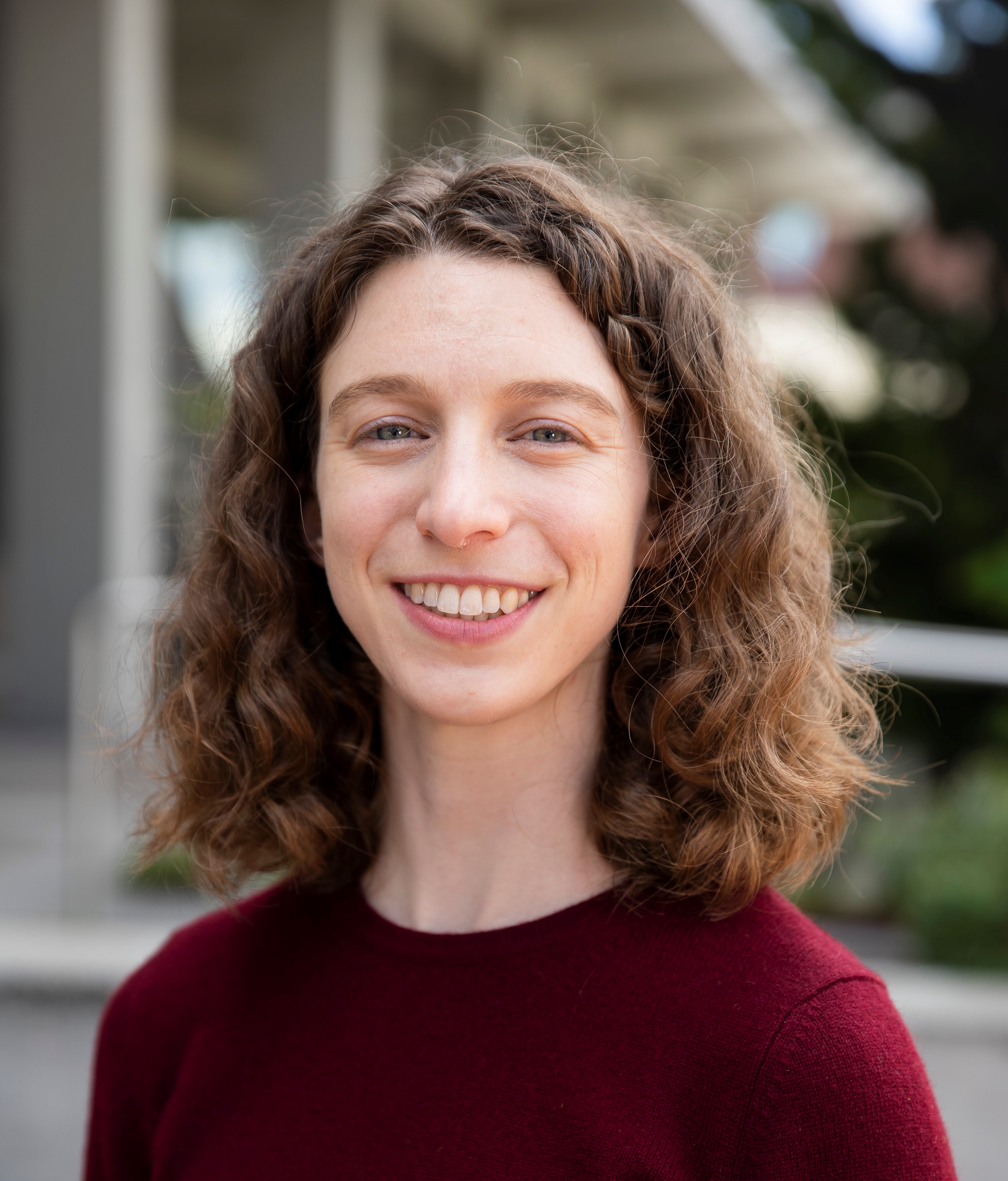
Megan Jackson
Assistant Professor
Murray 2202E919-962-8039
Megan.Jackson@unc.edu
Group Website
Research Interests
Energy conversion, electrochemistry, inorganic chemistry, materials chemistry, physical chemistry, electron transfer, catalysis
Research Synopsis
The Jackson lab aims to address global energy challenges by bringing atomistic and molecular-level design to heterogeneous electrocatalysis for energy conversion. We will use tools from physical electrochemistry, inorganic chemistry, and materials chemistry to answer the central question in electrocatalysis: when and how fast do bonds form and break at electrode surfaces? We will design and study electrochemical systems that allow us to readily extract key kinetic and thermodynamic parameters and will use the resulting knowledge to design more efficient electrocatalysts. Students in the group will become experts in electrochemistry, the synthesis and characterization of electrode materials, and chemical kinetics as they prepare to become leaders in the chemistry, materials science, and energy spaces.
Professional Background
California Institute of Technology, B.S. (2013), Massachusetts Institute of Technology, Ph.D. (2019), Arnold O. Beckman Postdoctoral Fellow, UC Berkeley (2020-2022)
News & Publications

Each holiday season, UNC chemist Erin Baker and her lab trade data analysis for presents — rallying fellow Tar Heels to raise money for Toys for Tots and Coats for Kids.

Sarah Rehm, a chemistry major, is studying how pollution from a group of toxic compounds known as PFAS, or forever chemicals, is affecting pets and wildlife..
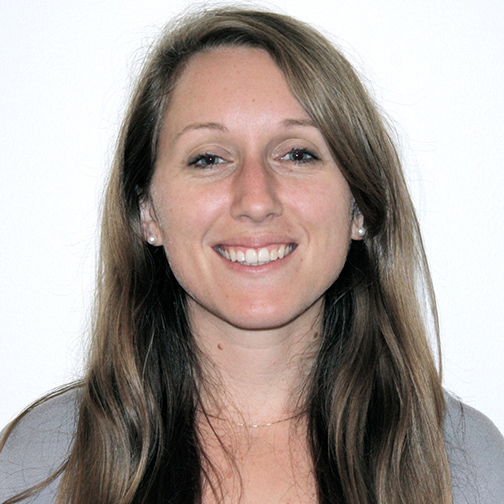
Elizabeth Brunk
Assistant Professor, Jointly Appointed with the Department of of Pharmacology in the School of Medicine
Genome Sciences Building919-843-7100
elizabeth_brunk@med.unc.edu
Group Website
Research Interests
Functional genomics, cancer systems biology, multi-omics, bioinformatics, precision medicine
Research Synopsis
Research in the Brunk laboratory focuses on developing computational methods that accelerate the clarity and utility of omics data in biomedical science. Our aim is understanding the link between genetic/molecular variation and phenotype, both in natural and engineered cellular systems. We approach these topics through the lens of computational biology, machine learning and advanced data integration. Thanks to the growing body of cancer omics data, our methods borrow strength across genomics, transcriptomics, ribosome profiling, proteomics, structural genomics, metabolomics and phenotype variability data.
Our research has uncovered patterns in variants that co-occur in three-dimensional protein space and their downstream, molecular and clinical phenotypes. We also develop methods that explore how cells respond to drugs and genetic engineering. Broadly speaking, we aim to better understand how cells achieve regulation at multiple scales of complexity and which genetic and molecular variants influence this process.
Professional Background
News & Publications

Each holiday season, UNC chemist Erin Baker and her lab trade data analysis for presents — rallying fellow Tar Heels to raise money for Toys for Tots and Coats for Kids.

Sarah Rehm, a chemistry major, is studying how pollution from a group of toxic compounds known as PFAS, or forever chemicals, is affecting pets and wildlife..
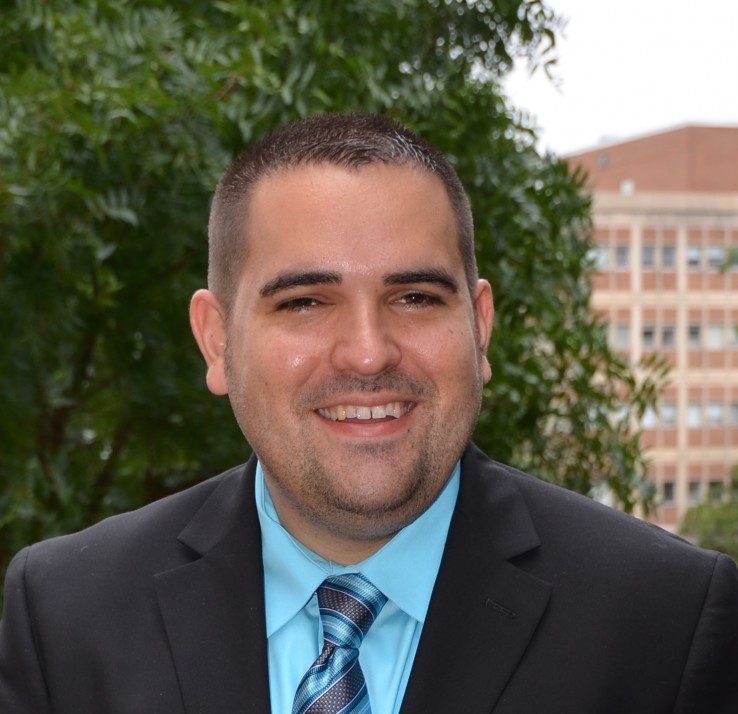
Jason Surratt
Cary C. Boshamer Distinguished Professor, Jointly Appointed with Gillings School of Global Public Health
Rosenau Hall 164(919) 966-0470
surratt@unc.edu
Group Website
Curriculum Vitae
Research Interests
Atmospheric analytical chemistry, Atmospheric chemistry, Environmental chemistry, Chromatographic techniques, Mass spectrometry, Multiphase chemistry, Organic aerosol chemistry
Research Synopsis
Professor Surratt specializes in atmospheric chemistry fundamentals. Dr. Surratt's lab utilizes advanced mass spectrometry and chromatographic techniques to understand as deeply as possible the atmospheric chemistry that occurs in both the gas and particulate phases, with special focus on the chemistry leading to the formation of secondary organic aerosol (SOA).
Since SOA is a major fraction of atmospheric fine particulate matter, chemically characterizing it resolves its sources and impacts on climate, air quality, and public health. By using this approach, Dr. Surratt has helped to reveal the detailed chemical pathways leading to SOA formation from the atmospheric oxidation of isoprene (the most abundant non-methane hydrocarbon on Earth) in the presence of anthropogenic pollutants.
Professor Surratt is also interested in applying analytical chemistry tools to study emerging pollutants (e.g., PFASs and electronic cigarettes) in fine particulate matter collected from indoor and outdoor air. By applying analytical chemistry tools to emerging pollutants, we can better assess the sources, potential transformations, and ultimate fates of these chemicals in the environment. This work aids in risk assessment and potential public health impacts.
Professional Background
Professor Surratt earned his B.S. in Meteorology and B.A. in Chemistry from NC State University. He earned his Ph.D. in Chemistry from the California Institute of Technology. Since 2010, Surratt has been teaching in the Department of Environmental Sciences & Engineering here at UNC Chapel Hill. He has also served as Program Director of the N.C. Per- and Polyfluoroalkyl Substance Testing Network since 2018.
Dr. Surratt's research combines synthetic, organic, and atmospheric analytical chemistry with toxicogenomics, toxicology and systems biology.
Awards, Accomplishments, & Service:
Health Effects Institute (HEI) Walter A. Rosenblith New Investigator Award, 2012; American Association for Aerosol Research (AAAR) Sheldon K. Friedlander Award, 2013; Environmental Protection Agency (EPA) Early Career Award, 2013; Camille & Henry Dreyfus Environmental Chemistry Mentor, 2013; Ruth and Philip Hettleman Prize for Artistic and Scholarly Achievement, UNC-CH, 2015; ACS James J. Morgan Environmental Science & Technology Early Career Award Lectureship, 2016; Atmospheric Chemistry and Physics; Co-Editor, 2016-Present; Newton Underwood Award for Excellence in Teaching, Gillings School of Global Public Health, 2017 & 2020; ACS Earth and Space Chemistry, Editorial Board Member, 2017-Present; ACS ES&T Letters Selected Highly Prolific Authors, 2017; Elected to the Board of Directors for AAAR, 2017-2020; Teaching Innovation Award, Gillings School of Global Public Health, 2018; ACS ES&T Letters 2018 Best Paper Award for “Effect of Aerosol-Phase State on Secondary Organic Aerosol Formation from the Reactive Uptake of Isoprene-Derived Epoxydiols (IEPOX),” 2019.
Research Group
News & Publications

Each holiday season, UNC chemist Erin Baker and her lab trade data analysis for presents — rallying fellow Tar Heels to raise money for Toys for Tots and Coats for Kids.

Sarah Rehm, a chemistry major, is studying how pollution from a group of toxic compounds known as PFAS, or forever chemicals, is affecting pets and wildlife..

Andrey Dobrynin
Mackenzie Distinguished Professor
Caudill Laboratories 119(919) 962-1580
avd@email.unc.edu
Group Website
Curriculum Vitae
Research Interests
Theoretical/Computational materials chemistry, Polymer and soft matter theory, Physical chemistry
Research Synopsis
My research is focused on development of computational and theoretical models of network and gels, polyelectrolyte solutions and gels, charged polymers at surfaces and interfaces, electrostatic interactions in biological systems, wetting and adhesion, graphene based polymeric materials, nanocomposites, soft-matter physics and biophysics. New directions include development of computer models for 3D printing and advanced additive manufacturing, computationally driven and AI based materials design, statistical data analysis and “big” data visualization. The knowledge gained from these studies impacts numerous areas of Soft Matter and Polymer Science.
Professional Background
Andrey V. Dobrynin is Mackenzie Family Eminent Distinguished Professor of Chemistry. He received B.S. (1987) and Ph.D. (1991) degrees in Polymer Physics from the Moscow Institute of Physics and Technology, Moscow, Russia.
Before joining University of North Carolina at Chapel Hill in summer 2020, he was Alan N. Gent Ohio Research Scholar, Professor of Polymer Science at the College of Polymer Science and Polymer Engineering, University of Akron (2015-2020), faculty at the Institute of Materials Science, University of Connecticut (2001-2015), served as a Program Director of the Condensed Matter and Materials Theory Program, Division of Materials Research at the National Science Foundation (2013-2015).
Prof. Dobrynin is a Fellow of the American Physical Society, the American Association for the Advancement of Science, and the Polymer Division, the American Chemical Society and Member of the Connecticut Academy of Science and Engineering.
News & Publications

Each holiday season, UNC chemist Erin Baker and her lab trade data analysis for presents — rallying fellow Tar Heels to raise money for Toys for Tots and Coats for Kids.

Sarah Rehm, a chemistry major, is studying how pollution from a group of toxic compounds known as PFAS, or forever chemicals, is affecting pets and wildlife..
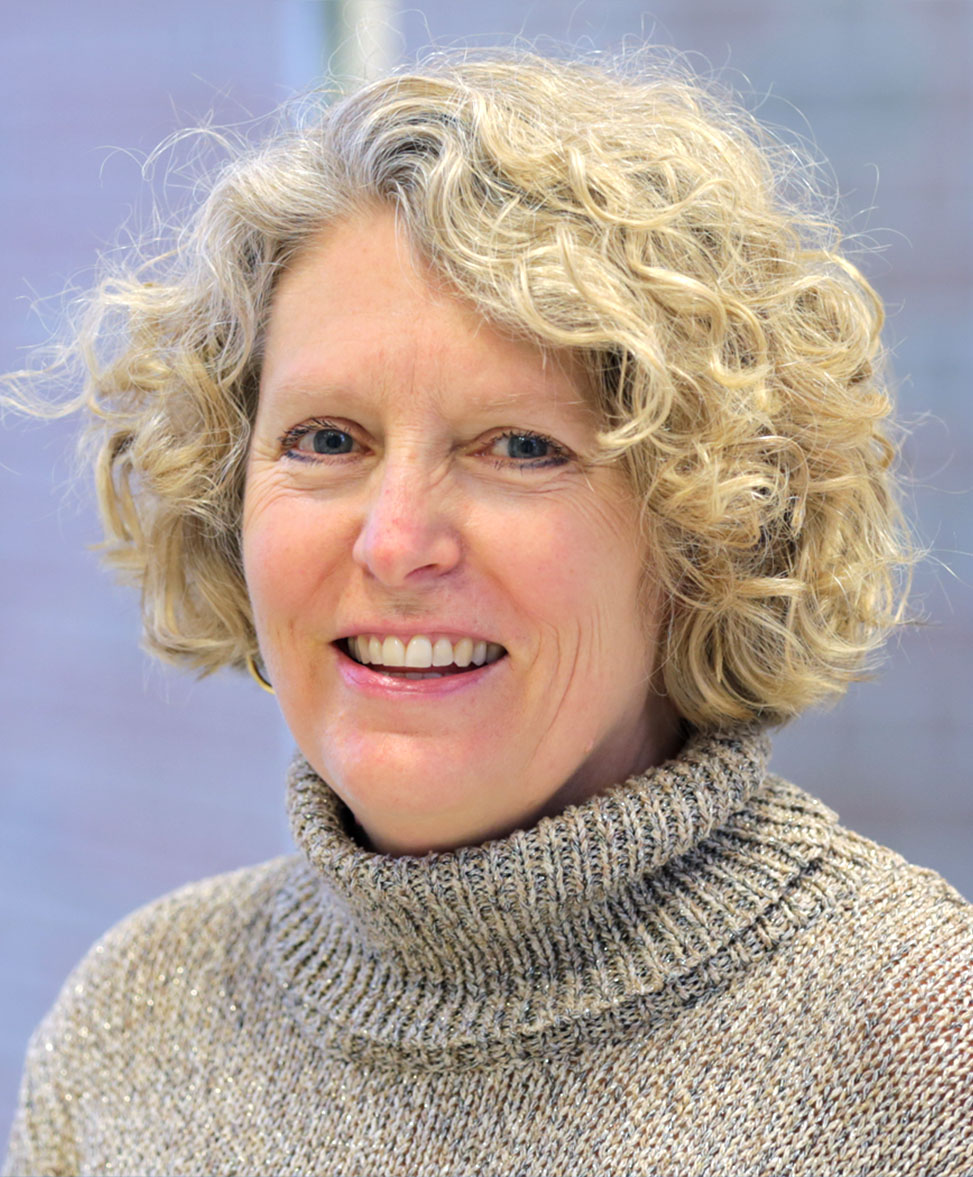
Nita Eskew
Teaching Professor
Kenan Laboratories A500919-962-4796
neskew@email.unc.edu
Curriculum Vitae
Research Interests
Chemistry Education, Organic Chemistry
Research Synopsis
Sharing the excitement of chemistry with students in the lab and classroom is my passion. After implementing the first research project into the organic chemistry lab, CURE, my goal is to continue the introduction of research into the undergraduate lab curriculum. Additionally, I have an interest in medicinal plants and developed the APPLES course, 'Chemistry of Purslane'.
Professional Background
B.S. Chemistry, University of North Carolina at Chapel, 1985. Ph.D. Chemistry, University of North Carolina at Chapel Hill, 1989. Bayer Corporation, 1989-2001. Associate Professor, Salem College, 2001-2012. Director of Undergraduate Laboratories, 2012-present. Student Undergraduate Teaching Award, 2017
News & Publications

Each holiday season, UNC chemist Erin Baker and her lab trade data analysis for presents — rallying fellow Tar Heels to raise money for Toys for Tots and Coats for Kids.

Sarah Rehm, a chemistry major, is studying how pollution from a group of toxic compounds known as PFAS, or forever chemicals, is affecting pets and wildlife..
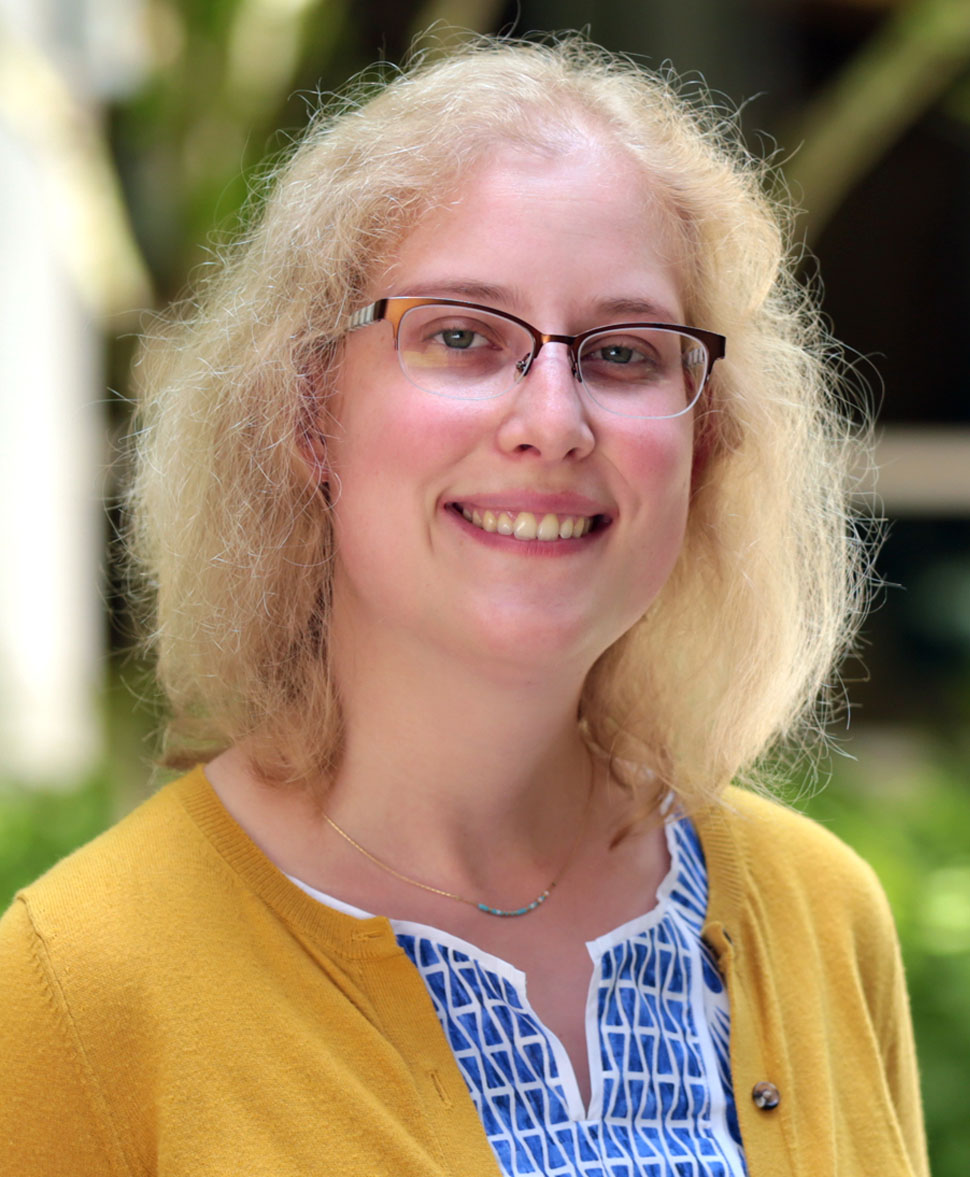
Anna Curtis
Teaching Associate Professor
Kenan Laboratories C147E919-962-3804
accurtis@email.unc.edu
Research Interests
Chemistry Education
Research Synopsis
My graduate work focused on understanding the electronic dynamics in semiconductor nanomaterials with applications in solar cell technology as well as studying students’ ability to think scientifically in the general chemistry classroom. The current focus of my research lies in chemical education, particularly in course assessment and reform. I have been involved in curriculum development for the general chemistry classroom and laboratory with a focus on scientific thinking and inclusion.
As both a teacher and researcher I am committed to constantly improving my knowledge of current research and best practices in chemical education as well as incorporating this knowledge into my teaching. I believe that it is essential to both implement these best practices and to continuously assess their effect on student learning. My interest in chemical education is driven by my belief that, with the right attitude and environment, all students are capable of learning chemistry.
Professional Background
B.S. Chemistry, University of North Carolina at Chapel Hill, 2012; Ph.D., Physical Chemistry, University of Colorado Boulder, 2018; Postdoctoral Teaching Fellow, Radford University, 2018-2019; Teaching Assistant Professor, University of North Carolina at Chapel Hill, 2019-present.
News & Publications

Each holiday season, UNC chemist Erin Baker and her lab trade data analysis for presents — rallying fellow Tar Heels to raise money for Toys for Tots and Coats for Kids.

Sarah Rehm, a chemistry major, is studying how pollution from a group of toxic compounds known as PFAS, or forever chemicals, is affecting pets and wildlife..

Alex Zhukhovitskiy
William R. Kenan, Jr. Fellow/Associate Professor
Murray Hall 2202J919-962-4054
alexzhuk@email.unc.edu
Group Website
Research Interests
Polymer chemistry and soft materials: organic synthesis, inorganic/organometallic/nano- catalysis, and supramolecular self-assembly.
Research Synopsis
In our Plastics Age, technological progress is limited by available polymeric materials. The intricate structure of polymers presents a formidable challengebut also an exciting opportunityto develop tactics and strategies that grant synthetic precision in such a complex setting. In the Zhukhovitskiy laboratory, the desired precision is engendered through the development of controlled/living polymerization methodology and original implementations of self-assembly concepts in soft materials.
Precision affords the practitioner exquisite control over materials properties and function, as well as the ability to test and refine our understanding of underlying structure-property relationships. Ultimately, we aim to unravel the links among polymer structure at different size scales, topology, and emergent physics, as well as to advance the application of soft materials in biomedical engineering, energy capture and conversion, surface patterning, and sustainability initiatives. Examples of target material classes include 1) entangled polymer networks, 2) conjugated block copolymers, and 3) heteroatom-rich polymers.
Research Program
Research in the Zhukhovitskiy group draws upon organic synthesis, organometallic and inorganic catalysis, nanoscience, supramolecular self-assembly, and polymer science, and consequently, group members receive a highly interdisciplinary training: from design, to synthesis, and ultimately characterization and property evaluationboth in the context of small molecules and polymers. Collaboration, often critical to the success of interdisciplinary projects, is encouraged in our group.
Undergraduates, graduate students, and postdocs with a passion for any flavor of synthesis and/or an interest in macromolecules are welcome to apply!
Representative Publications before UNC
1. Zhukhovitskiy, A. V.;# Kobylianskii, I. J.;# Wu, C.-Y.; Toste, F. D. Migratory Insertion of Carbenes into Au(III)C Bonds. J. Am. Chem. Soc. 2018, 140, 466474.
2. Zhukhovitskiy, A. V.; Mavros, M. G.; Queeney, K. T.; Wu, T.; Van Voorhis, T.; Johnson, J. A. Reactions of Persistent Carbenes with Hydrogen-Terminated Silicon Surfaces. J. Am. Chem. Soc. 2016, 138, 86398652.
3. Zhukhovitskiy A. V.; Zhong, M.; Keeler, E. G.; Michaelis, V. K.; Sun, J. E. P.; Hore, M. J. A.; Pochan, D. J.; Griffin, R. G.; Willard, A. P.; Johnson, J. A. Highly Branched and Loop-rich Gels via Formation of Metal-organic Cages Linked by Polymers. Nat. Chem. 2016, 8, 3341.
# contributed equally
Professional Background
20162019: LSRF Merck Postdoctoral Fellow with Professor F. Dean Toste, University of California, Berkeley, 20112016: Ph.D. with Professor Jeremiah A. Johnson, Massachusetts Institute of Technology,
20072011: BA/MS in Chemistry, BA in Mathematics and Integrated Science Program, Northwestern University
News & Publications

Each holiday season, UNC chemist Erin Baker and her lab trade data analysis for presents — rallying fellow Tar Heels to raise money for Toys for Tots and Coats for Kids.

Sarah Rehm, a chemistry major, is studying how pollution from a group of toxic compounds known as PFAS, or forever chemicals, is affecting pets and wildlife..
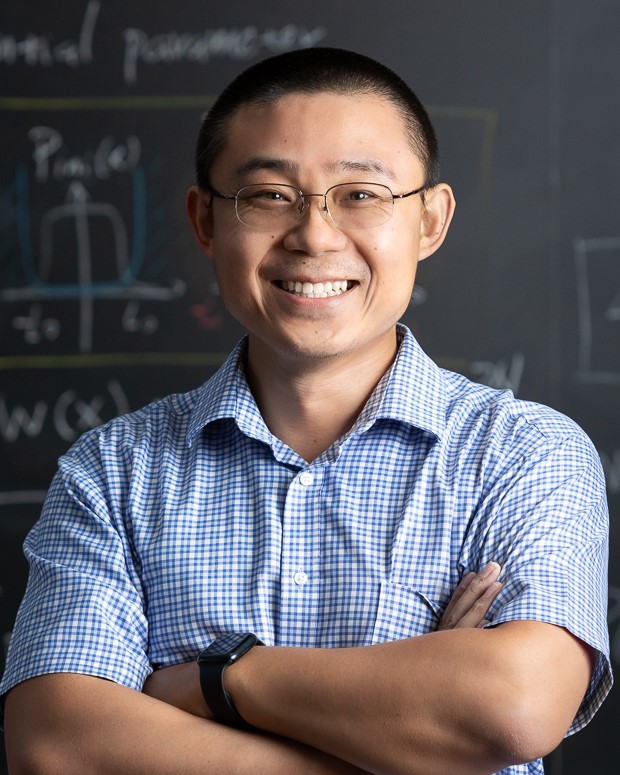
Zhiyue Lu
Assistant Professor
Caudill Laboratories 20919-962-1696
zhiyuelu@unc.edu
Group Website
Curriculum Vitae
Research Interests
Nonequilibrium thermodynamics, theoretical and computational statistical mechanics, molecular machines, chemical physics of living systems.
Research Synopsis
Living cells use highly complex, nonequilibrium and dynamic mechanisms to transduce energy, sense, process information, adapt, make decisions, and generate motion. These cellular functions are carried out very far from thermal equilibrium, and they are surprisingly robust against large environmental fluctuations. Due to the nonequilibrium nature and the complexity of these cellular processes, they cannot be described well by existing statistical physics theories. The Lu research group combines nonequilibrium thermodynamics theory and numerical simulation approaches to reveal the fundamental physical principles underlying these complex cellular functions. Furthermore, we apply these principles to designing smart artificial materials and biomimetic devices. The range of applications include self-healing materials, programmable biomedical nanorobots, and adaptive drug delivery system. Specific topics of our focus include temporal-responsive materials, cellular information processing, biochemical analog computers, kinetically enhanced molecular separation, and energy harvesting from nonequilibrium environments. Please feel free to contact me to suggest your brilliant ideas. We welcome applications from talented undergraduate, graduate, and postdoctoral scholars. We seek individuals from varied academic backgrounds, with interests in thermodynamics, statistical mechanics, biological physics, computational biology, and complex systems.
Professional Background
Postdoctoral Scholar University of Chicago, 2016-2019; Ph.D. University of Maryland at College Park, 2016; B.E. Beijing University of Chemical Technology, Beijing, China, 2010
News & Publications

Each holiday season, UNC chemist Erin Baker and her lab trade data analysis for presents — rallying fellow Tar Heels to raise money for Toys for Tots and Coats for Kids.

Sarah Rehm, a chemistry major, is studying how pollution from a group of toxic compounds known as PFAS, or forever chemicals, is affecting pets and wildlife..


